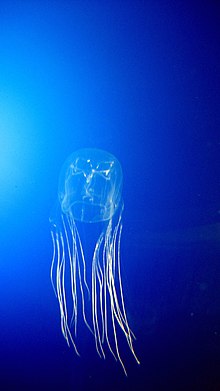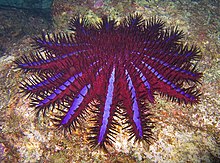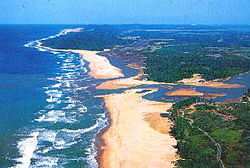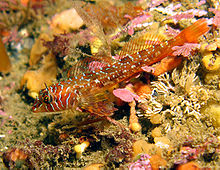Chironex fleckeri
From Wikipedia, the free encyclopedia
Chironex fleckeri 
Scientific classification Kingdom: Animalia
Phylum: Cnidaria
Class: Cubozoa
Order: Chirodropida
Family: Chirodropidae
Genus: Chironex
Species: C. fleckeri
Binomial name Chironex fleckeri
Southcott, 1956
Chironex fleckeri, commonly known as sea wasp, is an infamous lethally venomous species of Box jellyfish living in northern Australia's coastal waters. It is considered the most lethal jellyfish in the world because of the numerous incidents resulting in injury or death to humans.[1][2]
The amount of venom in one animal is enough to kill 60 adult humans, about 70 children, or 87 babies.[3]
First aid consists of washing the sting area with vinegar, and in no circumstance should alcohol, alcohol-based lotions, or methylated spirits be applied. Cardiopulmonary resuscitation (CPR) may be required. Medical help should be sought as soon as possible after considering these needs.
Notorious for its dangerous sting, C. fleckeri has tentacles up to 3 metres (9.8 ft) long which are covered in thousands upon thousands of nematocysts which, on contact, release microscopic darts, each delivering an extremely powerful venom. Being stung invariably results in excruciating pain, and if the sting area is significant, an untreated victim may die in as little as 3 minutes. [3]
Contents
[hide]
[edit] Description
Chironex fleckeri is the largest of the cubozoans (commonly called box jellyfish), many of which may carry similarly toxic venom. Its bell grows to about the size of a basketball, and trails four clusters of 15 tentacles trailing from each of the four corners of the bell. The pale blue, virtually transparent creature is nearly impossible to see in its habitat, posing particular danger to swimmers.
When the jellyfish are swimming the tentacles contract so they are about 15 cm long and about 5 mm in diameter; when they are hunting, the tentacles are thinner and extend to about three meters long. The tentacles are covered with a high concentration of stinging cells called nematocysts which are activated by pressure and a chemical trigger; they react to proteinous chemicals. Box jellyfish are day hunters; at night they are seen resting on the ocean floor, apparently 'sleeping'. However, this 'sleeping' theory is still debated.[citation needed]
In common with other box jellyfish, Chironex fleckeri have four eye-clusters with twenty-four eyes. Some of these eyes seem capable of forming images, however it is debated whether they exhibit any object recognition or object tracking; it is also unknown how they process information from their sense of touch and eye-like light-detecting structures due to their lack of a central nervous system.
Chironex fleckeri live on a diet of prawns and small fish and are themselves prey to turtles, whose thick skin is impenetrable to the nematocysts of the jellyfish.
[edit] Distribution and habitat
The polyps are found in estuaries in northern Australia. The medusa is pelagic and is found in the coastal waters of northern Australia and adjacent areas of the tropical Indo-West Pacific, and are also found in southeastern Asia. They are not usually found on the reef.
 Box jellyfish warning signpost at a Cape Tribulation beach in Queensland, Australia.
Box jellyfish warning signpost at a Cape Tribulation beach in Queensland, Australia. [edit] Sting
Chironex fleckeri is best known for its extremely powerful and often fatal sting. The sting produces excruciating pain accompanied by an intense burning sensation, and the venom has multiple effects, attacking the nervous system, heart, and skin at the same time. While an appreciable amount of venom (contact from about ten feet or three metres of tentacle) needs to be delivered in order to have a fatal effect on an adult human, the potently neurotoxic venom is extremely quick to act. Fatalities have been observed as little as four minutes after envenomation, notably quicker than any snake, insect or spider, and prompting its description as the world's deadliest venomous animal. Frequently a person swimming who gets stung will undergo cardiac arrest or drown before they can even get back to the shore or boat.
If a person does manage to get to safety, treatment must be administered urgently. Dousing a sting with vinegar immediately inhibits any nematocysts which have not been activated,[4] whereas rubbing a sting or dousing with alcohol can encourage nematocysts to activate. After dousing with vinegar, rescue breaths and CPR may be required; for less serious stings, treatment with ice packs and antihistamines is an effective method of pain relief. [5]Adhering tentacles should be removed carefully from the skin using protected hands or tweezers. Removed tentacles remain capable of stinging until broken down by time and even dried and presumably dead tentacles can be reactivated if wetted. The Australian snake bite treatment using roller bandages to bandage the affected limb (with the aim of preventing distribution of the venom through the lymph and blood circulatory systems) was no longer recommended for box jellyfish envenomation after 2005. The change was prompted by research which showed that using bandages to achieve tissue compression provoked nematocyst discharge, despite the use of vinegar.
An antivenom to the Box Jellyfish's sting does exist. After the immediate treatment described above, it must be administered quickly. Hospitals and ambulance services near to where the jellyfish live possess it, and must be contacted as soon as possible. The jellyfish's venom is so powerful, however, that even if the victim does get to safety and have the immediate treatment given and contact the ambulance, they may die before the ambulance reaches them.
The box jellyfish is estimated to be the cause of at least one death a year in Australia, and the record has been about 67.
Chironex fleckeri and other jellyfish, including the Irukandji (Carukia barnesi), are abundant in the waters of northern Australia during the summer months (November to April or May). It is believed they drift into the aforementioned estuaries to breed. Signs like the one pictured are erected along the coast of North Queensland warning people of such, and few people swim during this period. Some people still do, however, putting themselves at great risk. At popular swimming spots, net enclosures are placed out in the water wherein people can swim but jellyfish cannot get in, keeping swimmers safe. The much smaller (but generally non-lethal) Irukandji, however, can pass through the nets and no known antivenom for its sting has been developed yet.
From Wikipedia, the free encyclopedia
| Chironex fleckeri | |
|---|---|
 | |
| Scientific classification | |
| Kingdom: | Animalia |
| Phylum: | Cnidaria |
| Class: | Cubozoa |
| Order: | Chirodropida |
| Family: | Chirodropidae |
| Genus: | Chironex |
| Species: | C. fleckeri |
| Binomial name | |
| Chironex fleckeri Southcott, 1956 | |
Chironex fleckeri, commonly known as sea wasp, is an infamous lethally venomous species of Box jellyfish living in northern Australia's coastal waters. It is considered the most lethal jellyfish in the world because of the numerous incidents resulting in injury or death to humans.[1][2]
The amount of venom in one animal is enough to kill 60 adult humans, about 70 children, or 87 babies.[3]
First aid consists of washing the sting area with vinegar, and in no circumstance should alcohol, alcohol-based lotions, or methylated spirits be applied. Cardiopulmonary resuscitation (CPR) may be required. Medical help should be sought as soon as possible after considering these needs.
Notorious for its dangerous sting, C. fleckeri has tentacles up to 3 metres (9.8 ft) long which are covered in thousands upon thousands of nematocysts which, on contact, release microscopic darts, each delivering an extremely powerful venom. Being stung invariably results in excruciating pain, and if the sting area is significant, an untreated victim may die in as little as 3 minutes. [3]
Contents[hide] |
[edit] Description
Chironex fleckeri is the largest of the cubozoans (commonly called box jellyfish), many of which may carry similarly toxic venom. Its bell grows to about the size of a basketball, and trails four clusters of 15 tentacles trailing from each of the four corners of the bell. The pale blue, virtually transparent creature is nearly impossible to see in its habitat, posing particular danger to swimmers.
When the jellyfish are swimming the tentacles contract so they are about 15 cm long and about 5 mm in diameter; when they are hunting, the tentacles are thinner and extend to about three meters long. The tentacles are covered with a high concentration of stinging cells called nematocysts which are activated by pressure and a chemical trigger; they react to proteinous chemicals. Box jellyfish are day hunters; at night they are seen resting on the ocean floor, apparently 'sleeping'. However, this 'sleeping' theory is still debated.[citation needed]
In common with other box jellyfish, Chironex fleckeri have four eye-clusters with twenty-four eyes. Some of these eyes seem capable of forming images, however it is debated whether they exhibit any object recognition or object tracking; it is also unknown how they process information from their sense of touch and eye-like light-detecting structures due to their lack of a central nervous system.
Chironex fleckeri live on a diet of prawns and small fish and are themselves prey to turtles, whose thick skin is impenetrable to the nematocysts of the jellyfish.
[edit] Distribution and habitat
The polyps are found in estuaries in northern Australia. The medusa is pelagic and is found in the coastal waters of northern Australia and adjacent areas of the tropical Indo-West Pacific, and are also found in southeastern Asia. They are not usually found on the reef.

[edit] Sting
Chironex fleckeri is best known for its extremely powerful and often fatal sting. The sting produces excruciating pain accompanied by an intense burning sensation, and the venom has multiple effects, attacking the nervous system, heart, and skin at the same time. While an appreciable amount of venom (contact from about ten feet or three metres of tentacle) needs to be delivered in order to have a fatal effect on an adult human, the potently neurotoxic venom is extremely quick to act. Fatalities have been observed as little as four minutes after envenomation, notably quicker than any snake, insect or spider, and prompting its description as the world's deadliest venomous animal. Frequently a person swimming who gets stung will undergo cardiac arrest or drown before they can even get back to the shore or boat.
If a person does manage to get to safety, treatment must be administered urgently. Dousing a sting with vinegar immediately inhibits any nematocysts which have not been activated,[4] whereas rubbing a sting or dousing with alcohol can encourage nematocysts to activate. After dousing with vinegar, rescue breaths and CPR may be required; for less serious stings, treatment with ice packs and antihistamines is an effective method of pain relief. [5]Adhering tentacles should be removed carefully from the skin using protected hands or tweezers. Removed tentacles remain capable of stinging until broken down by time and even dried and presumably dead tentacles can be reactivated if wetted. The Australian snake bite treatment using roller bandages to bandage the affected limb (with the aim of preventing distribution of the venom through the lymph and blood circulatory systems) was no longer recommended for box jellyfish envenomation after 2005. The change was prompted by research which showed that using bandages to achieve tissue compression provoked nematocyst discharge, despite the use of vinegar.
An antivenom to the Box Jellyfish's sting does exist. After the immediate treatment described above, it must be administered quickly. Hospitals and ambulance services near to where the jellyfish live possess it, and must be contacted as soon as possible. The jellyfish's venom is so powerful, however, that even if the victim does get to safety and have the immediate treatment given and contact the ambulance, they may die before the ambulance reaches them.
The box jellyfish is estimated to be the cause of at least one death a year in Australia, and the record has been about 67.
Chironex fleckeri and other jellyfish, including the Irukandji (Carukia barnesi), are abundant in the waters of northern Australia during the summer months (November to April or May). It is believed they drift into the aforementioned estuaries to breed. Signs like the one pictured are erected along the coast of North Queensland warning people of such, and few people swim during this period. Some people still do, however, putting themselves at great risk. At popular swimming spots, net enclosures are placed out in the water wherein people can swim but jellyfish cannot get in, keeping swimmers safe. The much smaller (but generally non-lethal) Irukandji, however, can pass through the nets and no known antivenom for its sting has been developed yet.
Box jellyfish
From Wikipedia, the free encyclopedia
| | This article's factual accuracy is disputed. Please see the relevant discussion on the talk page. (October 2009) |
| Box Jellyfish | |
|---|---|
 | |
| "Cubomedusae", from Ernst Haeckel's Kunstformen der Natur, 1904 | |
| Scientific classification | |
| Kingdom: | Animalia |
| Phylum: | Cnidaria |
| Class: | Cubozoa Werner, 1975 |
| Orders | |

Box jellyfish, named for their cube-shaped medusae, are a class of invertebrates belonging to the class Cubozoa, as well as being the preferred common name for notoriously dangerous Chironex fleckeri. Box jellyfish are best known for the extremely powerful venom possessed by some of their species. Along with Chironex fleckeri, Carukia barnesi and Malo kingi are amongst the most venomous creatures in the world. Stings from such species are excruciatingly painful, either initially or as an after-effect, and are often fatal to their prey and sometimes even for humans. However, not all species of box jellyfish are this dangerous to humans.
Contents[hide] |
[edit] Nomenclature
The Cubozoa class contains at least 19 different species, some of which are only slightly less lethal than C. fleckeri.
The ambiguous but commonly used terms sea wasp and marine stinger have in places been applied to some species of Cubozoans, but these names vastly understate the danger posed by Chironex fleckeri and Carybdea alata, and their inappropriate use may cause carelessness that could result in death.[original research?]
In at least one context where C. fleckeri occurs, the term box jellyfish is understood to only refer to this species, rather than the entire order. This is likely because of the considerable importance of wariness of C. fleckeri, compared to the relative unimportance of non-threatening species of box jellyfish to those inhabitants.[citation needed]
Cubozoans are categorized separately from other types of jellyfish and are considered more complex than Scyphozoans.
[edit] Range
Various types of box jellies, ranging in toxicity, can be found in northern Australia, the Philippines, Indonesia, Hawaii,[1] Vietnam, the Caribbean and other tropical areas. Box jellyfish are extremely venomous – even to humans. Some marine species (such as turtles) are immune to the venom, and are known to feed on the jellyfish.
[edit] Defense and feeding mechanisms
Box jellyfish venom is the most deadly in the animal kingdom[citation needed] and has caused at least 5,568 recorded deaths since 1954[citation needed]. Each tentacle has about 500,000 cnidocytes, harpoon-shaped needles that inject venom into the victim.[2] Most often, these fatal envenomations are perpetrated by the largest species of box jelly, Chironex fleckeri, owing to its high concentration of nematocysts, although at least two deaths in Australia have been attributed to the thumbnail-sized Carukia barnesi.[3] Those who fall victim to C. barnesi suffer severe physical and psychological symptoms known as Irukandji syndrome.[4] The box jellyfish actively hunts its prey, rather than drifting as do true jellyfish. It is capable of achieving speeds of up to 4 knots (1.8 m/s).[citation needed]
Box jellyfish are known as the "suckerpunch" of the sea not only because their sting is rarely detected until the venom is injected, but also because they are almost transparent.
The venom of cubozoans is very distinct from that of scyphozoans, and is used to catch prey (fish and small invertebrates which includes shrimp and bait fish) and for defense from predators, which include the Butterfish, Batfish [disambiguation needed], Rabbitfish, crabs (Blue Swimmer Crab) and various species of turtles (Hawksbill turtle, Flatback turtle). Sea turtles, however, are apparently unaffected by the sting and eat box jellies.
In northern Australia, the highest risk period for the box jellyfish is between October and May, but stings and specimens have been reported all months of the year. Similarly, the highest risk conditions are those with calm water and a light, onshore breeze; however, stings and specimens have been reported in all conditions.
[edit] Treatment of stings
If swimming at a beach where box jellyfish are known to be present, a bottle of vinegar is an extremely useful addition to the first aid kit. Once a tentacle of the box jellyfish adheres to skin, it pumps nematocysts with venom into the skin, causing the sting and agonizing pain. Following a sting, vinegar should be applied for a minimum of 30 seconds, resulting in the removal of any unfired nematocysts. A box jellyfish sting can kill a human.[5] Acetic acid, found in vinegar, disables the box jelly's nematocysts that have not yet discharged into the bloodstream (though it will not alleviate the pain). Vinegar may also be applied to adherent tentacles, which should then be removed immediately[6]; this should be done with the use of a towel or glove to avoid bringing the tentacles into further contact with the skin. These tentacles will still sting if separated from the bell, or if the creature is dead. Removing the tentacles without first applying vinegar may cause unfired nematocysts to come into contact with the skin and fire, resulting in a greater degree of envenomation.
Although commonly recommended in folklore and even some papers on sting treatment,[7] there is no scientific evidence that urine, ammonia, meat tenderizer, sodium bicarbonate, boric acid, lemon juice, freshwater, steroid cream, alcohol, cold packs, papaya, or hydrogen peroxide will disable further stinging, and these substances may even hasten the release of venom.[8] Pressure immobilization bandages, methylated spirits, or vodka should never be used for jelly stings.[6][9][10][11] Often in severe Chironex fleckeri stings, cardiac arrest occurs quickly, so cardiopulmonary resuscitation (CPR) can be life saving and takes priority over all other treatment options.











